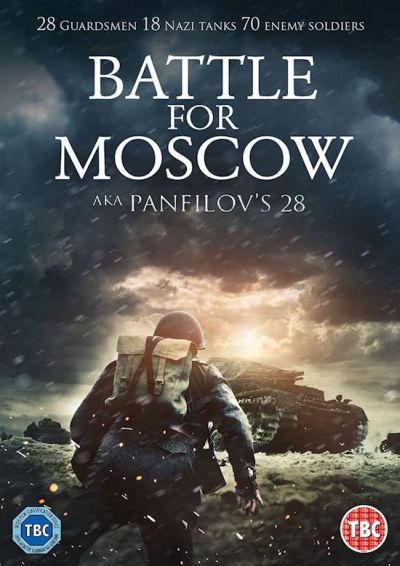| Title: | Panfilov's 28 Men / Battle for Moscow |
| Director: | Kim Druzhinin & Andrey Shalopa |
| Actors: | Maksim Abrosimov, Sergey Agafonov & Maksim Belborodov |
| Released: | 2016 |
| Publisher: | Panfilov's 28 Gaijin Entertainment |
| Play time: | 105 minutes |
| Description |
The Russian war movie Panfilov's 28 Men (Dvadtsat vosem panfilovtsev) describes 28 Red Army soldiers defending the Soviet Union in 1941 against attacks by Hitler-Germany during the battle for Moscow. Those soldiers served in the 316th Infantry Division. The movie is based on a propaganda legend. According to Soviet sources, all 28 soldiers were killed in action on November 16, 1941 having destroyed 18 German tanks in the process. After their death they were awarded the title Hero of the Soviet Union. At the end of the war an investigation into the historical accuracy of the story was launched in the Soviet Union in 1948. At the time, it was concluded the story was partially incorrect; not all 28 soldiers had died in 1941. Six of them were still alive. One of them was arrested in 1947 on charges of high treason and collaboration with German troops. The heroic actions of the soldiers were said to be exaggerated as well. On September 30, 1941, the Wehrmacht launched Operation Typhoon, the attack on Moscow. In November it had advanced to some 62 miles from the city. The Red Army's 316th Infantry Division was commanded by General Ivan Panfilov. He immediately attempted to halt the German advance. Defensive trenches were dug near Volokolamsk. The German 11. Panzer-Division closed in on Moscow. The movie shows how Soviet soldiers seek cover in trenches against enemy fire from artillery, tanks and and small arms. Armed with Mosin Nagant M1891 rifles, machinepistols (PPSh-41) and anti-tankweapons they attempt to halt the German advance. These weapons are almost useless against tanks. Therefore, 1.77 inch guns are being deployed to knock them out. As to graphics, the movie is very well made: explosions look realistic and the tanks of the German tankdivision have been reconstructed using scale models (sometimes full size). The reconstructed German PzKpfw III and IV look very realistic. Swastikas are painted on top of the hull and technical details are clearly visible (such as the details on the engine cover and the exhausts). It is clear to see that the PzKpfw IV was equipped with a short barrel cannon in 1941. This 75mm KwK 37 L/24 was capable of destroying vehicles as well as infantry with armor piercing grenades and hollow charges. In the movie, the PzKpfw III are equipped with 37mm cannon, just like they were in 1941. In the movie both German tanks are clearly distinguishable from each other, PzKpfw III has less wheels, a different silhouette and a lighter cannon. The firing of the tanks looks almost real, the guns fire realistically and the machine guns (7.92mm MG34) look like the real weapons. The movie script is partially based on fiction. Soviet journalist Vasily Koroteev learned from Serge Egorov, political commissar in 1941, about the heroic actions of the 28 soldiers. He and other journalists, including Aleksander Krivitsky published in newspapers like the Krasnaya Zvezda about the actions of these soldiers. In 1947, a military tribunal, headed by Lieutenant General Nikolai Afanasyev, investigated the story. They learned from Soviet soldiers that the heroic acts were not based on reality. Some of those present, including journalist Koroteev and David Ortenberg, editor of Krasnaya Zvezda claimend it was their intention to boost Soviet morale in and after 1941. In 1948, Afanasyev concluded that the story of Panfilov's 28 soldiers was based on fiction: the heroic defense of the small group of Soviet soldiers against the supremacy of German soldiers and tanks would never have taken place. Today, the story of Panfilov's 28 is a sensitive subject in Russia, some civilians and politicians are of the opinion that the story is based on facts while others disagree. Whatever the case, the fact remains that Soviet soldiers performed heroic acts in 1941 against the forces of Hitler-Germany. There are countless other stories that are historically correct: for instance the achievements of some Soviet tank aces destroying German tanks such as Dmitry Fyodorovich Lavrinenko (1914-1941). Neither can it be denied that the Soviet Union suffered the most losses against Hitler-Germany. According to academic sources, the number of victims among Soviet civilians and soldiers amount to some 20 million. (Cambridge History of Russia of 2006 claims the number to be between 24 and 26 million). The Soviet Union had been fighting against Hitler-Germany since 1941 and suffered far more human losses than Great Britain, the United States or any other country. With that in mind, we can argue that this movie really is a tribute to the individual Soviet civilian or soldier who gave his life to defend the Soviet Union (and the rest of the world) against the racist Nazi dictatorship. It is a fact that Russian propaganda played a big role in 1941 but that does not mean we must ignore or deny the individual courage of Soviet civilians or soldiers. Between 1941 and 1945 that courage was exaggerated by Soviet propaganda – in order to boost morale – but it must have frequently been a fact in its own right. Panfilov's 28 may be a movie based on Soviet propaganda but it also makes the viewer aware of the large scale Soviet resistance against the Nazi terror. Notwithstanding the fact that the movie is largely based on a myth, the special effects, the weapons used and the equipment are realistic. The war settting has also been reconstructed realistically. All told, Panfilov's 28 therefore is a fine war movie. |
| Rating: |    (Good) (Good) |
Information
- Translated by:
- Arnold Palthe
- Article by:
- Ruben Krutzen
- Published on:
- 02-05-2019
- Last edit on:
- 04-05-2019



